




An Introduction to Cyclic Quadrilateral
To understand what a cyclic quadrilateral is, we should know what quadrilaterals are. A quadrilateral is called a closed, two-dimensional geometrical figure with four sides, four angles, and four vertices. Square, rectangle, rhombus, and trapezium are a few examples of quadrilaterals.
A four-sided shape that a circle can encircle is a cyclic quadrilateral. The quadrilateral ABCD in the given figure is cyclic because each of its four vertices—A, B, C, and D—lies on the circle's circumference. The cyclic quadrilateral, its definition, theorems, properties, angles, and examples of cyclic quadrilateral problems with solutions are all covered in detail in this article.
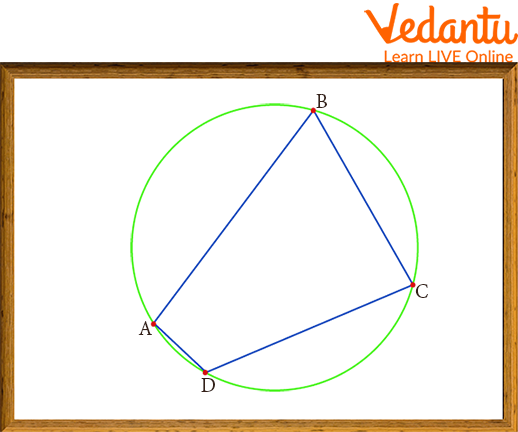
An Inscribed or Cyclic Quadrilateral
Properties of Cyclic Quadrilateral
Here some properties of cyclic quadrilateral angles are listed below:
The total of either pair of opposite angles in a cyclic quadrilateral is supplementary, i.e. 180 degrees.
For a quadrilateral to be cyclic, its opposing angles must be supplementary to one another.
In a cyclic quadrilateral, the sum of the products of its two pairs of opposite sides equals the product of the diagonals.
In a cyclic quadrilateral exterior angle is equal to the interior opposite angle if only one side is produced.
Angles of Cyclic Quadrilateral
Let's assume that
Join the circle's centre
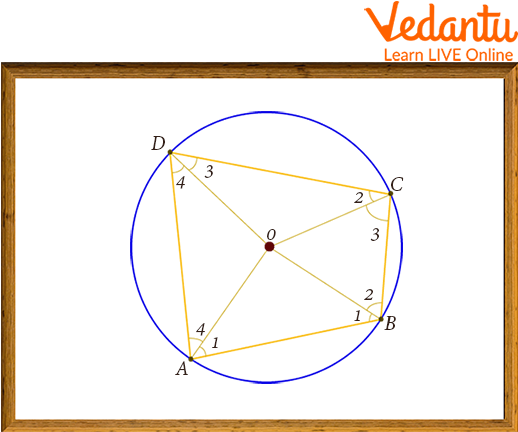
Cyclic Quadrilateral ABCD
Therefore, we get from the figure:
We now interpret this as:
1.
2.
Cyclic Quadrilateral Theorems
There are three main theorems on the cyclic quadrilateral. These are discussed below.
Theorem 1: “In a cyclic quadrilateral, the sum of either pair of opposite angles is supplementary.”
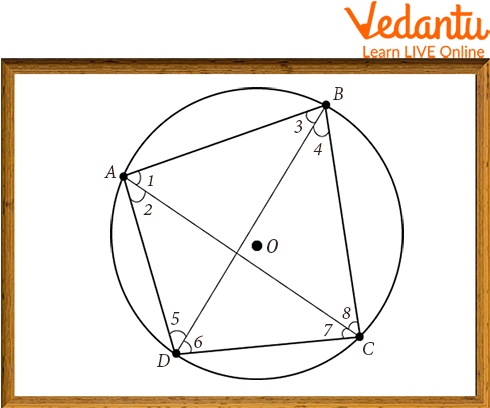
Cyclic Quadrilateral ABCD
Proof: Given: ABCD is a cyclic quadrilateral of a circle with a centre at
To prove:
By angle sum property of a quadrilateral
From equation
Similarly,
Hence proved.
Theorem 2: Ptolemy’s Theorem: “If there is a quadrilateral inscribed in a circle, then the product of the diagonals is equal to the sum of the product of its two pairs of opposite sides.”
If ABCD is a cyclic quadrilateral,
AB and CD, and AD and BC are opposite sides.
AC and BD are the diagonals.

Cyclic Quadrilateral (Ptolemy's Theorem )
(AB×CD)+(AD×BC)=AC×BD
(AB×CD)+(AD×BC)=AC×BD
Theorem 3: “If one side of a cyclic quadrilateral is produced, then the exterior angle is equal to the interior opposite angle.”
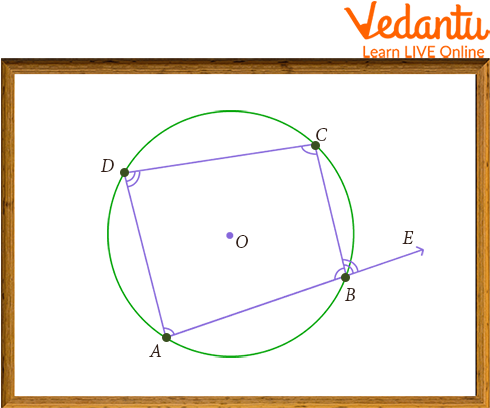
Cyclic Quadrilateral
To prove:
Proof:
Let the side
Here,
From this,
and finally, we get
Similarly, we can prove it from all angles.
Solved Examples
Example 1: If ABCD is a cyclic quadrilateral, find the value of x and y.
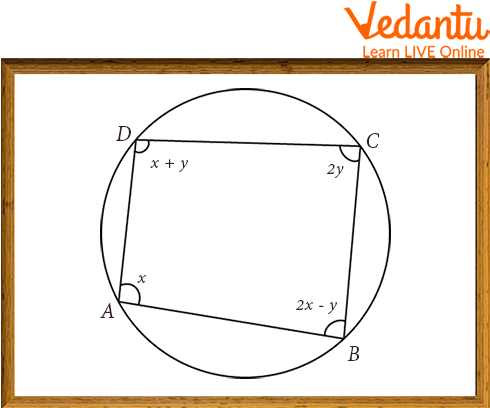
Cyclic Quadrilateral
Solution: We know that the sum of opposite angles of a cyclic quadrilateral is 180.
Therefore, from the figure
Also,
Substitute
Hence, the value of
Example 2: If PS || RQ and PQRS are cyclic quadrilaterals, determine the value of
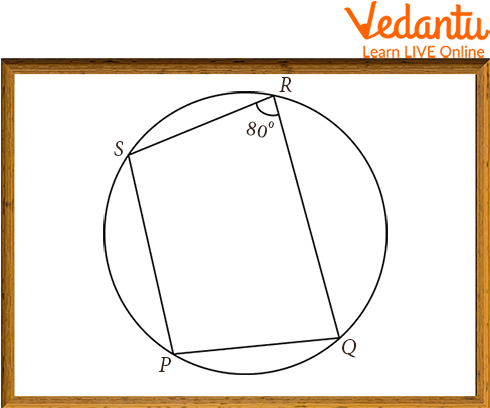
Cyclic Quadrilateral
Solution: PQRS is a cyclic quadrilateral, so the sum of either pair of opposite angles is 180 degrees.
Given PS || RQ. So, the Sum of interior angles is
Hence, the value of
Practice Questions
Q 1. PQRS is a cyclic quadrilateral. Diagonal PR and QS meet at A. If
(a)
(b)
(c)
(d)
Ans: (a)
Q 2. In a cyclic quadrilateral ABCD,
(a)
(b)
(c)
(d)
Ans: (b)
Summary
The four sides of a cyclic quadrilateral are the chords of the circle. An inscribed quadrilateral is another term for the cyclic quadrilateral. For a quadrilateral to be cyclic, its opposing angles must be supplementary to one another. The cyclic quadrilateral, its definition, theorems, properties, angles, and examples of cyclic quadrilateral problems with solutions are all covered in detail in this article. We hope this article will clear all our doubts regarding this topic.
FAQs on Cyclic Quadrilateral
1. What are the properties of cyclic quadrilaterals?
The properties of a cyclic quadrilateral are listed below:
|
|
|
|
|
|
|
|
|
2. What is a cyclic quadrilateral?
A four-sided geometric figure whose vertices lie on the circumference of the circle is known as a cyclic quadrilateral. It is a two-dimensional figure having four vertices and four edges.
3. Are all rectangles cyclic?
Yes, all rectangles are cyclic, but many quadrilaterals are not cyclic. As we know that if the opposite angles of a quadrilateral are supplementary which means that the sum of either pair of opposite angles is equal to 180 degrees, only then it is cyclic.
4. Do all the four perpendicular bisectors of the sides of the circular quadrilateral pass through a common point? Explain.
Yes, the vertices of the cyclic quadrangle are on the circle, which means that the vertices are at an equal distance from the circle to the centre of the circle. The perpendicular bisector of a line segment is a collection of equidistant points from the line segment endpoint as the centre of the circle is equidistant from all vertices (the endpoints of the line segments that make up the circle). On the sides of the cyclic quadrilateral, the centre is located on all four perpendicular bisectors of the quadrilateral.
5. Is a parallelogram a cyclic quadrilateral?
No, not every parallelogram is a cyclic quadrilateral. It is because the sum of the opposite angles of a parallelogram is not always supplementary.
6. What function does a cyclic quadrilateral serve?
A quadrilateral that can be inscribed in a circle, or one that has a circle that passes through each of its four vertices, is known as a cyclic quadrilateral. Cyclic quadrilaterals are helpful in various geometry issues, especially those that refer to angle finding. Examples include a tabletop, book, picture frame, door, baseball diamond, and more. Due to their widespread use, quadrilaterals are used in graphic art, sculpture, logos, packaging, computer programming, and web design. Quadrilaterals are present in almost all facets of daily life.
7. Do all four of the circular quadrilateral's perpendicular bisectors pass through the same point? Explain.
True, the cyclic quadrangle's vertices are on the circle, which means their distances from the circle's centre to the circle are equal. Since the centre of the circle is equally spaced from each of the circle's vertices, the perpendicular bisector of a line segment is a group of central points from the line segment endpoint (the endpoints of the line segments that make up the circle). The centre is shared by all four perpendicular bisectors of the sides of the cyclic quadrilateral.
8. Can a parallelogram be a cyclic quadrilateral?
Yes, for a parallelogram to be a cyclic quadrilateral, its opposite angles must be supplementary. Furthermore, all four vertices must be on the circumference. As a result, a parallelogram can also be a cyclic quadrilateral.











